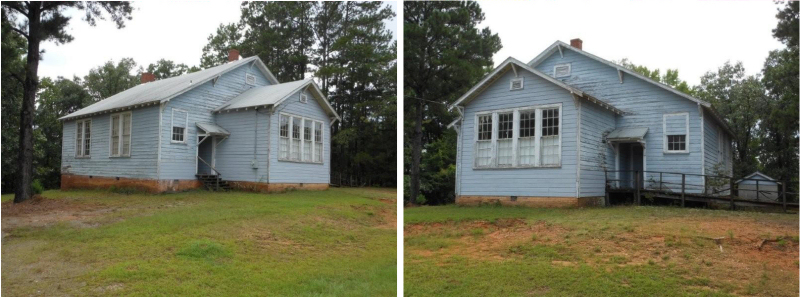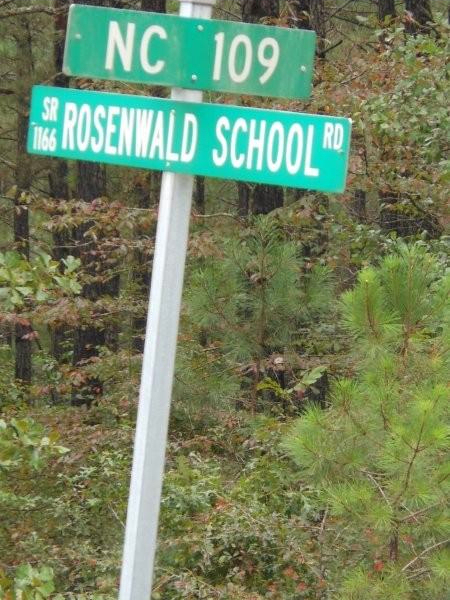
Liberty Hill School in the Covington Community is the only Richmond County Rosenwald School on the National Register of Historic Places. The only other schoolhouse on the Register is the Bostick Schoolhouse on Clayton Carriker Road, Ellerbe, maintained by the Richmond County Historical Society.
“In Richmond County between 1919 and 1930, twenty-one Rosenwald schools were erected, ranging from one-teacher to ten-teacher facilities.” – The Architectural History of Richmond County, North Carolina.
That number of Rosenwald schools is given by the North Carolina State Historic Preservation Office as of February 2013.
The Rosenwald schools had a direct impact in the lives of many black children in early educational efforts in Richmond County.
There were some 830 such schools in North Carolina built between the late 1910s and 1932. The state had more such schools than any other state in the nation at the time.
Prominent black educator Booker T. Washington convinced Chicago philanthropist and Sears, Roebuck and Company President Julius Rosenwald to fund schools in black communities beginning in 1917.
He agreed if communities would match his donations. All but seven counties in North Carolina had the schools. The match included land donated for the buildings.
Carolina Country studies said, “The legacy of the Rosenwald schools is a cornerstone in the foundation of North Carolina’s public education system.”
They said, “These small, wooden buildings … once served as the center of rural black community life.”
There is some disparity in records as to what schools in Richmond County were Rosenwald. Carolina Country lists the Covington (Liberty) Rosenwald School, Covington Community; and the Diggs Rosenwald School, Diggs Community.
National Register
 State Preservation also lists the Liberty Hill (Covington) School, 243 Covington Community Road, Ellerbe vicinity. It is the only Rosenwald School in the county listed on the National Register of Historic Places in 2008. Built in 1930, it replaced the old 1870s Liberty Hill School.
State Preservation also lists the Liberty Hill (Covington) School, 243 Covington Community Road, Ellerbe vicinity. It is the only Rosenwald School in the county listed on the National Register of Historic Places in 2008. Built in 1930, it replaced the old 1870s Liberty Hill School.
The only other schoolhouse in the county listed on the Register is the Bostick Schoolhouse on Clayton Carriker Road, Ellerbe, maintained by the Richmond County Historical Society.
Next is the Green’s Chapel School (old Grace Chapel Church), Grace Chapel Road, Hamlet, built about 1923. It replaced the District No. 3, Marks Creek Township School built in 1902. It became a church in 1952.
Morrison Grove School, west side of Airport Road, 0.4 miles northwest of its junction with N.C. 177, Hamlet, is a modified 1924 Rosenwald plan.
Therefore, there are four Rosenwald Schools identified in Richmond County. Seventeen others remain unidentified as such.
There were many schools already in the county before the Rosenwald construction. J.E. and Ida Huneycutt in their 1976 History of Richmond County, listed 22 other schools for “colored” students in a 1906-1907 account:
Beaver Dam, Hoffman, McNair, Holly Grove, East Hamlet, Cognac, Wayman, Green Springs, Flint Hill, Malee, Poplar Springs, Northam, Pleasant Hill, Lethe, Sugar Loaf, Philadelphia, Chestnut, Mt. Airy, Snow Hill, Hudson, St. Stephens, and Ashley.
The Huneycutts list many African-American schools, but it is difficult to tell which ones were Rosenwald Schools considered among the 21 said to have existed, except for the four mentioned.
At the same time, there were 36 schools for white students. In 1840, Richmond County had 22 of the first 60 districts in North Carolina to meet requirements for state aid for public schools. There were no public schools in the state from 1865 to 1872.
In 1885, when Scotland County was still part of Richmond County, there were 31 white schools and 25 schools for blacks. School terms were only eight to 12 weeks.
In 1892, the average length of the school term dropped to six weeks for white children and 10 weeks for black. By 1906, the terms increased to 105 days for whites and 95 days for blacks. Average daily attendance for whites was 60 percent; 46 percent for blacks.
At that time, 37 of all the school houses were made of logs. All this school information is from the Honeycutt History of Richmond County book.
In 1920-1921 when the Rosenwald projects would have begun, the Huneycutts reported there were 72 schools included in the county school system, 42 for white and 30 for black.
Liberty Hill
The Architectural History has a full description of the Liberty Hill (Covington) School which can reflect features that may have existed in many of the other Rosenwald schools in the county.
The school was believed to have been established in 1875 when public education in North Carolina was officially segregated. Carrie Alsobrook was the first teacher.
Many of the children attending Liberty Hill School were probably the children of former slaves who lived on the large plantations of northeastern Richmond County’s Pee Dee River Valley, according to the National Park Service.
The Park Service said the school’s early activities received strong support from the local African American community. It said, “A local observer noted in 1884, ‘The Negroes seem to take a great deal more interest in educating their children than the white people do’.”
An 1892 deed for the school lot notes that it was located on the old Plank Road that once passed through northern Richmond County from Salisbury to Fayetteville which then crossed the Pee Dee River near the Grassy Islands fording area.
The present remaining 1930 Rosenwald (Covington) School, which replaced the former Liberty School, is a gable-fronted frame building with “novelty weatherboard siding.” Rosenwald Fund Floor Plan No. 2-C, called it a “Two Teacher Community School to Face North or South Only.” It was among the last to be built in the nation, in 1930-1931.
A front wing of the building was for an Industrial Room for home economics for the girls and farm work with tool training for the boys. On each side of the wing are doors. An interior partition divided the classrooms. One of the two cloakrooms was later converted to a bathroom.
After WWII, the Mineral Springs School in Ellerbe for blacks expanded, and the Covington School was merged with it in 1947-1948. It was, the last of the early all-black schools in the county. In 2006, Covington School was sold for private use.
Tom MacCallum
Richmond County Historical Society
